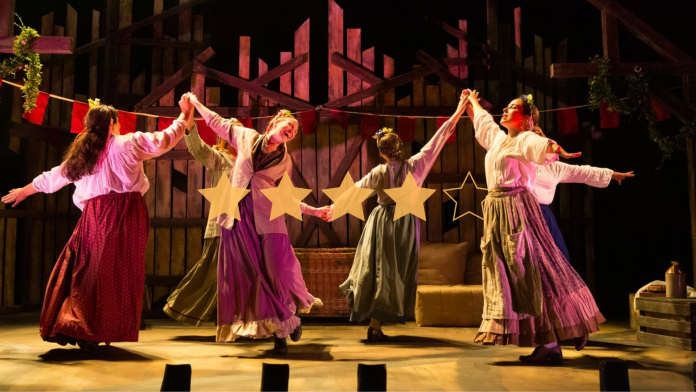★★★★✰
The story of Maria Marten appears to be done and dusted: murdered by her husband and buried beneath the ‘Red Barn’, her death has been told and retold in books, plays, TV series and films. Writer Beth Flintoff, director Hal Chambers and their cast challenge this assertion. Maria is allowed to speak her own history: one which defiantly excludes her killer.
Throughout the show, Maria retells her own story, as other roles of her friends, family and lovers are taken by the all-female ensemble cast. They are consistently strong in portraying the value of female community, when they clean Maria’s hair and face of blood, as well as in demonstrating the difficulties of feminine experience in the 19th century. There is not a weak link within the cast, and the majority jump between children to men to gentry within the space of two or three scenes—impressively convincing. So too are the show’s central themes. From God to gaslighting, the show never strays from difficult topics, but also emphasises that there was joy and strength in Maria’s life. As portrayed by Elizabeth Crarer, our heroine is allowed to be witty, feisty and heartbreakingly young; a fully-rounded person trapped within a particular society.
Costume and set are used to emphasise these attributes, whilst ensuring that the audience’s focus is never taken from Maria’s murder. The set is designed to resemble the Red Barn, placing the audience within the infamous site as both voyeur and victim. Costumes are simple but effective, most strikingly used when the cast dresses and undresses Maria, either as an act of confinement or liberation. Music is also a consistent component, and while it reemphasises the communal happiness of her early life, it is often overused and sometimes begins to feel like filler, especially in overlong dance sequences.
The emphasis on movement is occasionally a problem elsewhere in the drama, as moments of over-direction take us out of Maria’s story and into an experimental movement piece. Additionally, some of Maria’s emotions seem a tad one-note: Crarer arrives on the verge of tears and stays there throughout the piece, sometimes even during happy scenes. However, these are only vaguely problematic: it is a testament to the overall strength of the show that any problems are only found in the small details.
The Ballad of Maria Marten is an exceptional show for many reasons. It gives a voice back to the voiceless, acknowledges the ambiguities of historical fact, and is often very, very funny. It boasts a superb cast without a weak link, and manages to carry the audience along for two hours plus an interval without it feeling like a chore. It is possibly the best thing I’ve seen in London this year, and to miss it on tour would be criminal.
Words by Issy Flower
Support The Indiependent
We’re trying to raise £200 a month to help cover our operational costs. This includes our ‘Writer of the Month’ awards, where we recognise the amazing work produced by our contributor team. If you’ve enjoyed reading our site, we’d really appreciate it if you could donate to The Indiependent. Whether you can give £1 or £10, you’d be making a huge difference to our small team.
